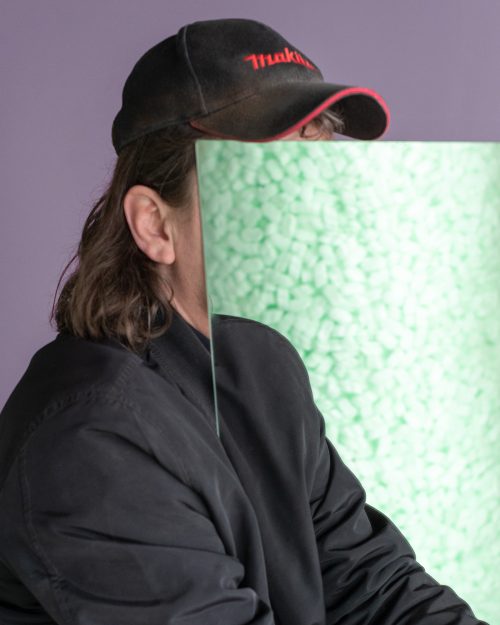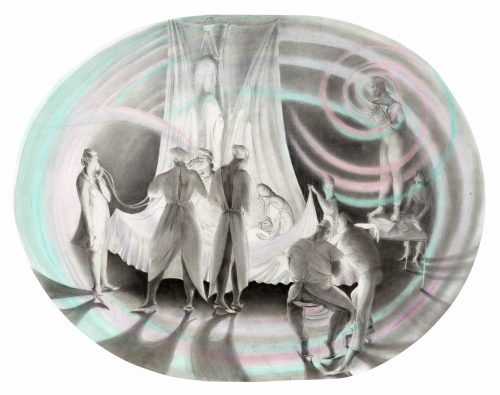
Maryna Sakowska, Jan Eustachy Wolski
Double bind
Project Info
- 💙 Pilot, Vienna
- 💚 Niclas Schöler
- 🖤 Maryna Sakowska, Jan Eustachy Wolski
- 💜 Niclas Schöler
- 💛 Flavio Palasciano
Share on

exhibition view
Advertisement

exhibition view

Maryna Sakowska, Construction 3 (Roundup circuit), 2023, pencil and crayon on paper, A4

Maryna Sakowska, Construction 3 (Roundup circuit), 2023, pencil and crayon on paper, A4

exhibition view

exhibition view

Maryna Sakowska, Construction 5 (Virgo Lactans), 2023, pencil on paper, A4

Maryna Sakowska, Construction 4 (Desiring-machine), 2023, pencil and crayon on paper, A4

exhibition view

exhibition view

exhibition view

Jan Wolski, Untitled, 2023 digital print (framed) 27 x 23,5 cm

Maryna Sakowska, Community of fluids, 2023, oil and acrylics on canvas, 160 x 120 cm

Jan Wolski, Untitled, 2023 oil on canvas, 180 x 150 cm

Jan Wolski, Untitled, 2023 six xerox prits, dimensions variable

exhibition view
From the amoeba to Einstein, the progress of knowledge is always the same
Karl Popper
Objektive Erkenntnisse: Ein evolutionärer Entwurf (Hamburg: Hoffmann & Campe, 1974), p. 289
As a child, I received the book Apparitions in the Starry Sky by Walter Kraul, likely from my parents. The foreword says it is meant for „interested laymen,“ which leaves me uncertain if it was age-appropriate for my 11-year-old self. Recently, I revisited the book still on my shelf and realized I hadn‘t retained any of the text. While I know, for example, that the moon orbits the Earth, I am unaware whether it is from this book
that I received the information.
The numerous illustrations by Dazzel Kammerl were all the more familiar to me. On almost every double page there are sometimes larger, sometimes smaller pictures of constellations that move across the sky.cThe constellations are either depicted as small stars connected by lines that stretch across the firmament or as symbols of the tropical zodiac wandering across the sky. These signs seemed to whizz by and intersect in upward and downward trajectories (in some illustrations there are even several of them). In my imagination, these celestial formations would traverse the firmament all night, intersecting in various trajectories until morning‘s red-orange hues swallowed them .
The view of my real-night sky was all the more disappointing. For me, this sky had nothing to do with the illustrations from the book. Firstly, the color of the sky wasn’t right, well, it was ok. But above all, I was unable to spot any of the signs in the sky! This book which is meant to explain the scientific understanding of stars and constellations, seemed disconnected from the tangible world. I remember standing outside on the street holding the book in my hands and realizing that what I saw bore no resemblance to the illus-
trations.
Hello, do you have a minute to talk on the phone?
22:06
If so, give me a call
22:06
Do you remember the book
Apparitions in the Starry Sky,
that you once gave me?
22:09
In Stephen Hawking’s A brief History of Time Fig. 1 depicts the cosmological model of Aristotle and Ptolemy from the 2nd century AD. The book rested open on my windowsill for over a year to exactly this page. The book can no longer be closed unless you compress it between other books. The page with the model illustration has yellowed from a whole calendar year’s exposure to sunlight.
The Aristotelian-Ptolemaic model centers the earth, surrounded by eight spheres carrying the five known planets of the time (Mercury, Venus, Mars, Jupiter, and Saturn), along with the moon, sun, and stars. The outermost sphere carries the fixed stars. And what lay outside this was never explained, deemed beyond human comprehension.
Despite known contradictions between the model and observed reality, the model was more or less adhered to, as the Roman Catholic Church sought a system of the cosmos that allowed for an outside to place heaven and hell, and have humanity at the center. In 1609, Galileo Galileo, would observe the starry sky with a telescope he had invented the year prior, and discovered unknown celestial bodies not directly orbiting the earth. In 1633, he was sentenced to life imprisonment for his findings .
359 years later, Galileo was formally rehabilitated.
No, I don‘t remember that
unfortunately not
07:18
Ok, never mind
11:13
Niclas Schöler




